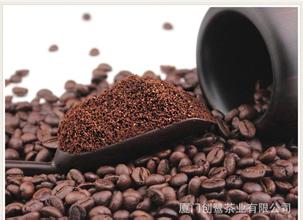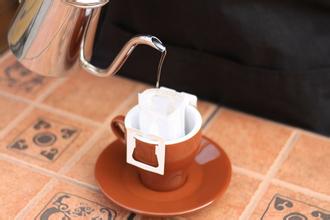Uganda Coffee Taste Characteristics Variety Treatments Flavor Description Manor
Flavor characteristics of Ugandan Coffee Variety treatment method to describe the Flavor of Manor
Will flow into the upper seat along the riser of the upper seat. When there is only 1 / 3 water left in the lower seat, pour the ground coffee powder into the upper seat and pour wet coffee powder from all sides to the middle with a bamboo stirring stick. 9) after the coffee powder is completely wet, start the clock (do not stir the coffee mixture at this time. This stage is called "stew"); 10) after about 45 seconds, use a bamboo stick to quickly stir the coffee solution. After a layer of foam appears on the liquid surface, the stirring can be stopped. Wait a few more seconds, the alcohol lamp can be removed and extinguished; 11) wipe the lower seat with a wet rag prepared in advance to cool the lower seat; the order of wiping is to wipe the bottom first and then wipe around, and do not stay in one position for too long, lest the lower seat burst due to uneven cooling. If you are skilled, wipe the lower seat with a rag in one hand and stir the coffee solution with a stirring stick in the other to speed up its cooling. 12) when the lower seat is not as expected, the internal pressure decreases, resulting in the coffee solution in the upper seat being sucked back to the lower seat (which is also the origin of the siphon pot name); 13) when the coffee solution in the upper seat is completely sucked back, pull out the upper seat and pour the coffee liquid in the lower seat into a pre-warmed coffee cup.
Ugandan coffee beans have a unique flavor of delicate taste, which is very suitable for making Italian and other flavors of coffee. More importantly, Ugandan coffee beans are strictly screened according to the standards of the international market to ensure their high quality and pollution-free characteristics.
Africa is the hometown of the two major varieties of coffee, Arabica and Robusta, while Uganda, which is located in eastern Africa and enjoys the laudatory names of "plateau water hometown" and "Pearl of East Africa", is believed by many people to be the birthplace of Robusta.
Most of Uganda is located in the Central African Plateau, with lakes, with an average elevation of 1000 mi 1200 meters. There are many lakes and plateaus in the mountains, which are known as "plateau water villages". The western branch of the East African Rift Valley runs through the western border, with many rivers and lakes at the bottom of the valley. Uganda has a great Victoria lake, coupled with the high mountains, which makes Uganda a mild climate suitable for growing coffee, although it spans both sides of the equator.
Uganda is the birthplace of Robusta in Africa, just as Ethiopia is the birthplace of Arabica coffee, which was first found in Uganda. So far, Uganda has a history of growing coffee for more than 100 years. The output ranks second in Africa, after Ethiopia. At the same time, Uganda is one of the few major countries in Africa dedicated to the production of organic coffee.
Uganda's best coffee is produced mainly in the mountains of Elgon and Bugisu along the Kenyan border in the north-east and Ruwensori in the west.
The cultivation of coffee in Uganda is all small-scale family operation. The livelihood of 25% of the population is closely related to coffee production. About 500000 farms grow coffee, but mainly Robster. Robusta accounts for 90% of coffee production, and the remaining 1 is Arabica coffee. Arabica and Robusta collect from October to February of the following year.

Important Notice :
前街咖啡 FrontStreet Coffee has moved to new addredd:
FrontStreet Coffee Address: 315,Donghua East Road,GuangZhou
Tel:020 38364473
- Prev

Taste treatment of Rosa Coffee Bean in Incht Manor, Guatemala
Taste treatment of Rose Summer Coffee beans in Incht Manor Guatemala varieties of Guatemalan coffee have a strong aroma, even if you don't drink it, just smelling it is already a pleasure. Antigua coffee has a rich and velvety mellow, rich and lively aroma, and fine sour taste. When the attractive fragrance lingers on the tip of your tongue, it implies a kind of indescribable
- Next

Introduction of flavor description and taste treatment method for classification characteristics of Ethiopian coffee beans
Ethiopian coffee bean species classification characteristics flavor description taste treatment method to introduce how many Arabica subspecies there are in Ethiopia, even the official research unit of Ethiopia does not know. The coffee cooperatives in this mountain are certainly different from those planted in another mountain, and even small farmers in the same region grow different varieties of coffee. Some people estimate that Ethiopian coffee arrives
Related
- Detailed explanation of Jadeite planting Land in Panamanian Jadeite Manor introduction to the grading system of Jadeite competitive bidding, Red bid, Green bid and Rose Summer
- Story of Coffee planting in Brenka region of Costa Rica Stonehenge Manor anaerobic heavy honey treatment of flavor mouth
- What's on the barrel of Blue Mountain Coffee beans?
- Can American coffee also pull flowers? How to use hot American style to pull out a good-looking pattern?
- Can you make a cold extract with coffee beans? What is the right proportion for cold-extracted coffee formula?
- Indonesian PWN Gold Mandrine Coffee Origin Features Flavor How to Chong? Mandolin coffee is American.
- A brief introduction to the flavor characteristics of Brazilian yellow bourbon coffee beans
- What is the effect of different water quality on the flavor of cold-extracted coffee? What kind of water is best for brewing coffee?
- Why do you think of Rose Summer whenever you mention Panamanian coffee?
- Introduction to the characteristics of authentic blue mountain coffee bean producing areas? What is the CIB Coffee Authority in Jamaica?

